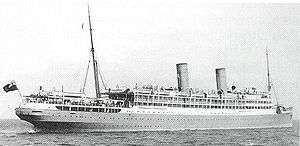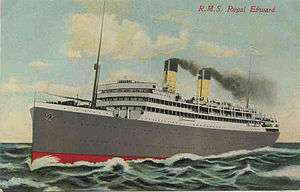HMT Royal Edward
RMS (later HMT[Note 1]) Royal Edward was a passenger ship belonging to the Canadian Northern Steamship Company that was sunk during the First World War with a large loss of life while transporting Commonwealth troops. She was launched in 1907 as RMS Cairo for a British mail service to Egypt.
 Royal Edward, c. 1910–14 | |
| History | |
|---|---|
| Name: |
|
| Owner: |
|
| Operator: | 1914: Admiralty |
| Port of registry: | |
| Route: |
|
| Builder: | |
| Yard number: | 450[1] |
| Launched: | July 1907[1] |
| Completed: | January 1908[1] |
| Fate: | sunk by UB-14, 13 August 1915 |
| General characteristics | |
| Type: | ocean liner |
| Tonnage: | 11,117 GRT[1] |
| Length: | 160.3 m (525 ft 11 in) (oa)[1] |
| Beam: | 18.4 m (60 ft 4 in)[1] |
| Propulsion: |
|
| Speed: | 19 knots (35 km/h)[1] |
| Capacity: |
|
| Troops: | 1,367[3] |
| Crew: | 220[3] |
| Notes: | two funnels, three masts[2] |
Design and construction
Cairo and sister ship Heliopolis were built by the Fairfield Shipbuilding and Engineering Company of Govan, Scotland.[3] Cairo was launched in July 1907 and entered service in January 1908.[1] As built, she was 160.3 metres (525 ft 11 in) long (overall) and 18.4 metres (60 ft 4 in) abeam. She was powered by three steam turbines that drove three propeller shafts, at up to 19 knots (35 km/h).[1] She could accommodate up to 1,114 passengers in three classes: 344 in first class, 210 in second class, and 560 in third.[2]
Prewar career

Cairo entered service for the Egyptian Mail Steamship Company, a British-owned company that provided a fast mail service between Marseilles and Alexandria. The service was not successful and Cairo and sister ship Heliopolis were laid up in 1909 when the service ended.[3]
Both ships were sold to the newly established Toronto-based Canadian Northern Steamship Company, a subsidiary of the Canadian Northern Railway, in 1910, operating under its Royal Line brand. Cairo was renamed Royal Edward, Heliopolis Royal George, and they were refitted for the North Atlantic. Royal Edward sailed from Avonmouth to Montreal in the summer and to Halifax in the winter.[2] At the outbreak of World War I Royal Edward and Royal George were requisitioned for use as troopships.[3]
World War I

Royal Edward was used to bring Canadian troops to Europe before being used as an internment ship anchored of Southend-on-Sea.[4]
On 28 July 1915, Royal Edward embarked 1,367 officers and men at Avonmouth.[lower-alpha 1] The majority were reinforcements for the British 29th Infantry Division, with members of the Royal Army Medical Corps. All were destined for Gallipoli.[5] Royal Edward was reported off the Lizard on the evening of 28 July, and had arrived at Alexandria on 10 August, a day after sister ship Royal George had sailed from Devonport. Royal Edward sailed for Moudros on the island of Lemnos, a staging point for the Dardanelles.[6]
On the morning of 13 August, Royal Edward passed the British hospital ship Soudan, heading in the opposite direction. Oberleutnant zur See Heino von Heimburg in the German submarine UB-14 was off the island of Kandeloussa and saw both ships. He allowed Soudan to pass unmolested, and focused his attention on the unescorted Royal Edward some 6 nautical miles (11 km) off Kandelioussa.[7] He launched one of UB-14's two torpedoes from about 1 mile (1.6 km) away and hit Royal Edward in the stern.[7][8] She sank by the stern within six minutes.[7]
Royal Edward was able to get off an SOS before losing power, and Soudan arrived on the scene at 10:00 after making a 180° turn and rescued 440 men in six hours. Two French destroyers and some trawlers rescued another 221. According to authors James Wise and Scott Baron, Royal Edward's death toll was 935 and was high because Royal Edward had just completed a boat drill and the majority of the men were below decks re-stowing their equipment.[7] Other sources report different numbers of casualties, from 132 [9] to 1,386 [10] or 1,865.[11] An Admiralty casualty list, published in The Times in September 1915, named 13 officers and 851 troops as missing believed drowned, a total of 864 lost, including posthumous Victoria Cross recipient Cuthbert Bromley and footballer Walter Miller.[12]
Gallery
Photos taken aboard the hospital ship Soudan.
 Survivors of Royal Edward in hospital gowns
Survivors of Royal Edward in hospital gowns Boat from the hospital ship Soudan looking for survivors
Boat from the hospital ship Soudan looking for survivors Survivors of HMT Royal Edward boarding Soudan
Survivors of HMT Royal Edward boarding Soudan Survivors on the rope ladder
Survivors on the rope ladder Survivors of HMT Royal Edward on an upturned boat
Survivors of HMT Royal Edward on an upturned boat Two boats of Royal Edward as sighted by Soudan
Two boats of Royal Edward as sighted by Soudan
See also
- List by death toll of ships sunk by submarines
References
- "Cairo/Royal Edward (1125656)". Miramar Ship Index. Retrieved 14 April 2009.
- Bonsor, Vol. 4, p. 1433.
- Wise and Baron, p. 75.
- "British Troop Ship Sunk." Times [London, England] 18 Aug. 1915: 7+. The Times Digital Archive. Web. 13 June 2015.
- Wise and Baron, pp. 75–76.
- Wise and Baron, p. 76.
- Wise and Baron, p. 77.
- Gardiner, p. 180.
- Tennent, pp. 36–37.
- Hendrickson, p. 270
- Gilbert, p. 185.
- "Deaths." Times [London, England] 6 Sept. 1915: 8. The Times Digital Archive. Web. 13 June 2015.
Bibliography
- Bonsor, N. R. P. (1975). North Atlantic Seaway: An Illustrated History of the Passenger Services Linking the Old World with the New (Enl. and rev. ed.). New York: Arco Pub. Co. OCLC 1891992.
- Gardiner, Robert, ed. (1985). Conway's All the World's Fighting Ships, 1906–1921. Annapolis, Maryland: Naval Institute Press. ISBN 978-0-87021-907-8. OCLC 12119866.
- Gilbert, Martin (1996) [1994]. The First World War: A Complete History (1st Owl books ed.). New York: Henry Holt. ISBN 978-0-8050-7617-2. OCLC 34792651.
- Hendrickson, Robert (1984). The Ocean Almanac (1st ed.). Garden City, New York: Doubleday. ISBN 978-0-385-14077-5. OCLC 8532256.
- Tennent, A. J. (2006) [1990]. British Merchant Ships Sunk by U boats in the 1914–1918 War. Penzance: Periscope Publishing. ISBN 1-904381-36-7.
- Wise, James E. & Baron, Scott (2004). Soldiers Lost at Sea: A Chronicle of Troopship Disasters. Annapolis, Maryland: Naval Institute Press. ISBN 978-1-59114-966-8. OCLC 52182511.
Further reading
- Oliff, Richard (2004). Fastest to Canada: The Royal Edward, from Govan to Gallipoli. Kettering: Silver Link. ISBN 1-85794-233-7.